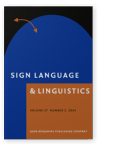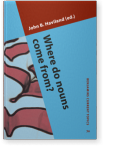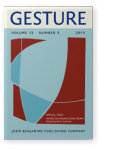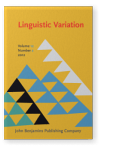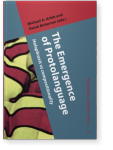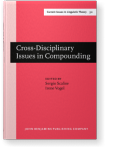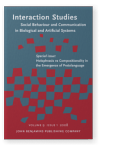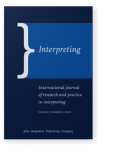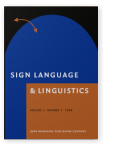Carol A. Padden
List of John Benjamins publications for which Carol A. Padden plays a role.
Journal
2015 Patterned iconicity in sign language lexicons Where do nouns come from?, Haviland, John B. (ed.), pp. 43–63 | Article
Iconicity is an acknowledged property of both gesture and sign language. In contrast to the familiar definition of iconicity as a correspondence between individual forms and their referents, we explore iconicity as a shared property among groups of signs, in what we call patterned iconicity. In… read more
2013 Patterned iconicity in sign language lexicons Where do nouns come from?, Haviland, John B. (ed.), pp. 287–308 | Article
Iconicity is an acknowledged property of both gesture and sign language. In contrast to the familiar definition of iconicity as a correspondence between individual forms and their referents, we explore iconicity as a shared property among groups of signs, in what we call patterned iconicity. In… read more
2012 The influence of community on language structure: Evidence from two young sign languages Linguistic Variation 12:2, pp. 247–291 | Article
By comparing two sign languages of approximately the same age but which arose and developed under different social circumstances, we are able to identify possible relationships between social factors and language structure. We argue that two structural properties of these languages are related to… read more
2010 The roots of linguistic organization in a new language The Emergence of Protolanguage: Holophrasis vs compositionality, Arbib, Michael A. and Derek Bickerton (eds.), pp. 133–152 | Article
It is possible for a language to emerge with no direct linguistic history or outside linguistic influence. Al-Sayyid Bedouin Sign Language (ABSL) arose about 70 years ago in a small, insular community with a high incidence of profound prelingual neurosensory deafness. In ABSL, we have been able to… read more
2010 Sign languages and compounding Cross-Disciplinary Issues in Compounding, Scalise, Sergio and Irene Vogel (eds.), pp. 301–322 | Article
Compounding is one of the few sequential word formation processes found across sign languages. We explore familiar properties of compounds in established sign languages like American Sign Language, as well as a modality-specific type of simultaneous compounding, in which each hand contributes a… read more
2008 The roots of linguistic organization in a new language Holophrasis vs Compositionality in the Emergence of Protolanguage, Arbib, Michael A. and Derek Bickerton (eds.), pp. 133–153 | Article
It is possible for a language to emerge with no direct linguistic history or outside linguistic influence. Al-Sayyid Bedouin Sign Language (ABSL) arose about 70 years ago in a small, insular community with a high incidence of profound prelingual neurosensory deafness. In ABSL, we have been able to… read more
2008 Foreword Sign Bilingualism: Language development, interaction, and maintenance in sign language contact situations, Plaza-Pust, Carolina and Esperanza Morales-López (eds.), pp. xi–xiv | Foreword
2000 Simultaneous Interpreting across Modalities Interpreting 5:2, pp. 169–185 | Article
In this paper I examine simultaneous sign language interpreting with a focus on two dimensions: interpreting between languages of different modalities, and interpreting between two different languages. As I discuss, there is interplay between the two: At times, the task at hand is modality-driven,… read more
1998 The ASL lexicon Sign Language & Linguistics 1:1, pp. 39–60 | Article
This paper explores a range of Foreign vocabulary in American Sign Language and demonstrates that there are ways of accounting for them without undermining the fundamental independence of a natural sign language. Arguments are made for a unified lexicon in which Native and Foreign vocabulary are… read more
